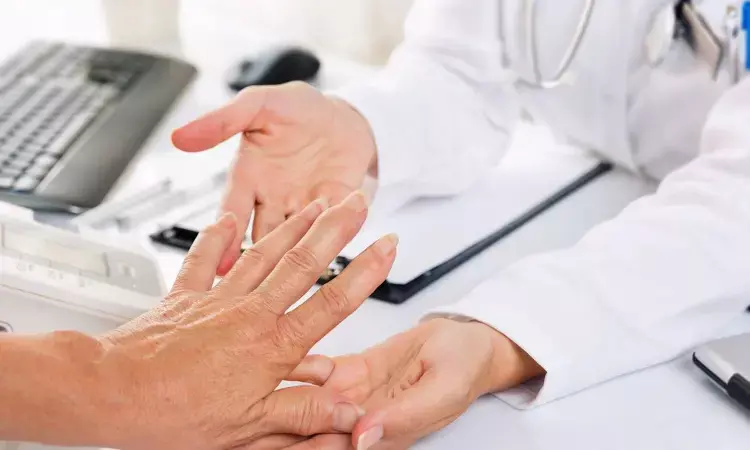- Home
- Medical news & Guidelines
- Anesthesiology
- Cardiology and CTVS
- Critical Care
- Dentistry
- Dermatology
- Diabetes and Endocrinology
- ENT
- Gastroenterology
- Medicine
- Nephrology
- Neurology
- Obstretics-Gynaecology
- Oncology
- Ophthalmology
- Orthopaedics
- Pediatrics-Neonatology
- Psychiatry
- Pulmonology
- Radiology
- Surgery
- Urology
- Laboratory Medicine
- Diet
- Nursing
- Paramedical
- Physiotherapy
- Health news
- Fact Check
- Bone Health Fact Check
- Brain Health Fact Check
- Cancer Related Fact Check
- Child Care Fact Check
- Dental and oral health fact check
- Diabetes and metabolic health fact check
- Diet and Nutrition Fact Check
- Eye and ENT Care Fact Check
- Fitness fact check
- Gut health fact check
- Heart health fact check
- Kidney health fact check
- Medical education fact check
- Men's health fact check
- Respiratory fact check
- Skin and hair care fact check
- Vaccine and Immunization fact check
- Women's health fact check
- AYUSH
- State News
- Andaman and Nicobar Islands
- Andhra Pradesh
- Arunachal Pradesh
- Assam
- Bihar
- Chandigarh
- Chattisgarh
- Dadra and Nagar Haveli
- Daman and Diu
- Delhi
- Goa
- Gujarat
- Haryana
- Himachal Pradesh
- Jammu & Kashmir
- Jharkhand
- Karnataka
- Kerala
- Ladakh
- Lakshadweep
- Madhya Pradesh
- Maharashtra
- Manipur
- Meghalaya
- Mizoram
- Nagaland
- Odisha
- Puducherry
- Punjab
- Rajasthan
- Sikkim
- Tamil Nadu
- Telangana
- Tripura
- Uttar Pradesh
- Uttrakhand
- West Bengal
- Medical Education
- Industry
Erosive hand osteoarthritis tied to articular structural damage and its progression: Study

Erosive hand osteoarthritis (EHOA) is a lesser-known type of osteoarthritis that affects approximately 3 per cent of people over 55 and 10 per cent of those with symptomatic hand OA. In a study, researchers have found that EHOA predominantly affects older adults and women with preexisting OA and are linked with severe articular structural damage and radiographic progression. The study findings were published in the journal Arthritis & Rheumatology on April 12, 2021.
The unique characteristics of EHOA suggest that pathological processes differ from those of typical hand OA (HOA). Dr Timothy E. McAlindon and colleagues wrote, "Better understanding the fundamental nature of EHOA could help clarify these processes and uncover potential therapeutic targets." Therefore, Dr McAlindon and his team conducted a study to evaluate age, sex, race, osteoarthritis severity, metabolic factors, and bone health as risk factors for incident erosive hand osteoarthritis (EHOA) at baseline and over 48 months.
It was a longitudinal cohort study of 3365 individuals from the Osteoarthritis Initiative with complete hand radiographs from baseline and 48-month visits. The researchers classified the individuals as having EHOA if they had Kellgren-Lawrence (KL) grade≥2 in at least one interphalangeal joint on two different fingers and central erosion in at least one joint.
Key findings of the study were:
- Among 3365 individuals, the researchers noted that 86 (2.6%) individuals developed EHOA during the 48 months.
- They found that older age (relative risk [RR] per standard deviation = 0.76), female sex (RR = 1.73), greater OA severity (sum of KL grade 13.9 vs 5.3,) and less cortical width (1.38 vs 1.52 mm) increases the risk of EHOA.
- After 48 months of follow up, they noted that individuals who developed EHOA were characterized by greater progressions of radiographic osteoarthritis. This includes joint space narrowing, KL grade progression (RRs = 1.35-1.9) and loss of cortical thickness (RR = 1.23), all adjusted for age, sex, race and BMI.
The authors concluded, "These findings present EHOA as a disorder of advanced age and female sex, strongly associated with severity of articular structural damage and its progression. Individuals who develop EHOA have thinner bones prior to EHOA development and as it progresses, suggesting EHOA as a disorder of skeletal frailty."
For further information:
Medical Dialogues Bureau consists of a team of passionate medical/scientific writers, led by doctors and healthcare researchers. Our team efforts to bring you updated and timely news about the important happenings of the medical and healthcare sector. Our editorial team can be reached at editorial@medicaldialogues.in.
Dr Kamal Kant Kohli-MBBS, DTCD- a chest specialist with more than 30 years of practice and a flair for writing clinical articles, Dr Kamal Kant Kohli joined Medical Dialogues as a Chief Editor of Medical News. Besides writing articles, as an editor, he proofreads and verifies all the medical content published on Medical Dialogues including those coming from journals, studies,medical conferences,guidelines etc. Email: drkohli@medicaldialogues.in. Contact no. 011-43720751


